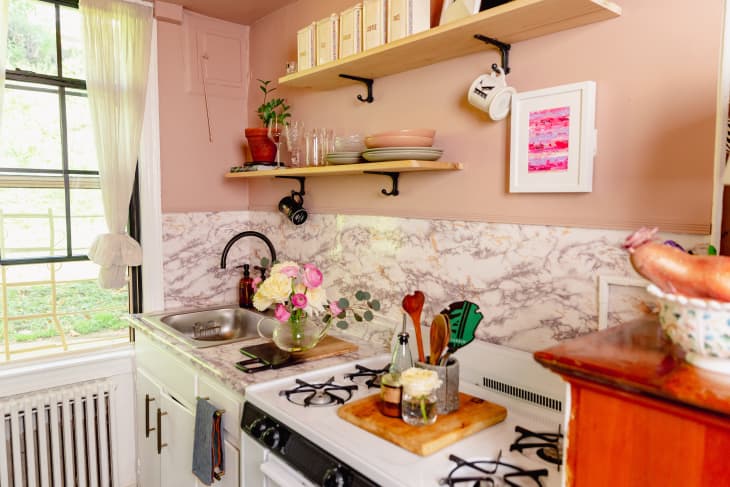4 Tips for Finding a Cheap Apartment, from an Expert Who’s Been There

Imani Keal has made a career out of living well in Washington, D.C. In the decade since she moved to attend Howard University, she has cultivated a “diverse and fun” community stretching from the suburbs to within walking distance of storied sights.
“I love living in a big city. I’m originally from Philly, but I appreciate small-town charm,” Keal says. “D.C. has the perfect mix.”
Four years ago, she moved into a studio apartment in Glover Park and showed neighbors and strangers just how great life could be in the nation’s capital — well, perhaps just how great life could be when you decide to turn a teeny rental into a personalized cocoon. Social media followers may know her better as Imani at Home, where she shares DIY projects and design ideas for small-space dwellers who want to learn how to thrive on a budget. And now that Keal has left her beloved studio behind for a two-bedroom in Dupont Circle, she’s now sharing her luxury-for-less ethos in yet another sphere: apartment hunting.
“Searching for an apartment is like going into Target,” she says. “If I don’t have a list, I’ll fixate on one beautiful aspect of the apartment and forget everything else I need.”
In the midst of moving, Keal chatted with Apartment Therapy about the four ways to manifest the perfect apartment in this city, from corralling necessary paperwork to negotiating before handing over your John Hancock. Here’s how she made her latest home happen.
You Need Up to Three Months to Search
Finding an apartment that’s more than a means of shelter takes time. Sure, you can find a spot in a pinch, but if you’re looking for a place that has a mix of must-haves and non-essentials, you’ll want to give yourself as long as three months to find it.
“If you don’t, you’ll end up with something that’s just okay,” Keal says.
Before you lace up your shoes and start touring, though, she recommends making a list describing your next address. She broke her list down into price, amenities, and location — details she refers to as the “renter’s trifecta” — and then kept a spreadsheet of the ones that fit the bill.
Keal says that her perfect D.C. apartment would be in a prewar building with south-facing light and original hardwood floors in great condition. There would be marble countertops and a doorman for packages, who would welcome her back after a short stroll to her favorite bars.
“But if this apartment really existed, it would probably be about $6,000 a month,” Keal said, who wanted to pay about half of that. “But a girl can dream.”
Open a Separate Bank Account
A timeframe of up to three months before your move-in date should give you a chance to throw as much cash as you can into savings. Keal transfers a security deposit, first and last month’s rent, and any moving expenses into a separate bank account so that the money is effortlessly available at her fingertips. This lump sum keeps her dreams in check, too.
“It makes things simpler because I know how much I can spend and won’t feel like I’m scrambling when it’s time to put together an application,” she says. “And speaking of applications, I always tell people to have their documents ready to go: W-2s, tax returns, bank statements, recommendations from previous landlords, and so on. Keep a digital folder, so it stays with you.”
Ask About Features, Even If You Compromise on Amenities
Keal knew at the outset of her search that she likely wouldn’t find everything she wanted. But if a contender showed promise, she did two things: One, she asked questions about the unit during the tour — like how long the lease is, any recent upgrades, how close public transportation is, and if it’s rent controlled — and even made sure to know where potential landlords stood on the possibility of future DIY projects. Secondly, she double-checked that the apartment was in a neighborhood she liked and within her budget.
“I can compromise on amenities, but not price or location,” she says. “Those two factors dictate how I’ll live life outside of the apartment, so I know if it’s something I can’t comfortably afford or it’s super far from everything I love, I wouldn’t enjoy living there at all.”
As for apartments that come with pros but one big con? “If you look at a place and you like it, but there’s one thing that keeps nagging you about it, don’t do it,” Keal says. “Your disdain will only grow.”
Get the Answers You Need, and Don’t Be Afraid to Negotiate
Keal gets it: “It’s nerve-racking touring apartments, especially when the landlord or property manager is following you closely in the space,” she says. But don’t let your nerves get the best of you if this is where you’ll be living for the foreseeable future. “People freeze up and forget to ask real questions.”
Aside from getting answers to the aforementioned prompts about the length of the lease and recent upgrades, you should also know how maintenance requests are handled and how much utilities will cost throughout the year. The landlord or property manager should also be able to tell you what the pet policy is, how secure the building is, and how often rent is increased. And, of course, they should be able to point your rent check in the right direction.
Once you get those answers and you have a contract in hand, Keal then recommends some light negotiating. “Leases are contracts, and contracts are meant to be negotiated,” she says. “No matter what the lease says, you are able to ask for modifications.”